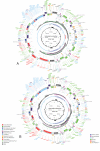Chloroplast genome sequencing analysis of Heterosigma akashiwo CCMP452 (West Atlantic) and NIES293 (West Pacific) strains
- PMID: 18462506
- PMCID: PMC2410131
- DOI: 10.1186/1471-2164-9-211
Chloroplast genome sequencing analysis of Heterosigma akashiwo CCMP452 (West Atlantic) and NIES293 (West Pacific) strains
Abstract
Background: Heterokont algae form a monophyletic group within the stramenopile branch of the tree of life. These organisms display wide morphological diversity, ranging from minute unicells to massive, bladed forms. Surprisingly, chloroplast genome sequences are available only for diatoms, representing two (Coscinodiscophyceae and Bacillariophyceae) of approximately 18 classes of algae that comprise this taxonomic cluster. A universal challenge to chloroplast genome sequencing studies is the retrieval of highly purified DNA in quantities sufficient for analytical processing. To circumvent this problem, we have developed a simplified method for sequencing chloroplast genomes, using fosmids selected from a total cellular DNA library. The technique has been used to sequence chloroplast DNA of two Heterosigma akashiwo strains. This raphidophyte has served as a model system for studies of stramenopile chloroplast biogenesis and evolution.
Results: H. akashiwo strain CCMP452 (West Atlantic) chloroplast DNA is 160,149 bp in size with a 21,822-bp inverted repeat, whereas NIES293 (West Pacific) chloroplast DNA is 159,370 bp in size and has an inverted repeat of 21,665 bp. The fosmid cloning technique reveals that both strains contain an isomeric chloroplast DNA population resulting from an inversion of their single copy domains. Both strains contain multiple small inverted and tandem repeats, non-randomly distributed within the genomes. Although both CCMP452 and NIES293 chloroplast DNAs contains 197 genes, multiple nucleotide polymorphisms are present in both coding and intergenic regions. Several protein-coding genes contain large, in-frame inserts relative to orthologous genes in other plastids. These inserts are maintained in mRNA products. Two genes of interest in H. akashiwo, not previously reported in any chloroplast genome, include tyrC, a tyrosine recombinase, which we hypothesize may be a result of a lateral gene transfer event, and an unidentified 456 amino acid protein, which we hypothesize serves as a G-protein-coupled receptor. The H. akashiwo chloroplast genomes share little synteny with other algal chloroplast genomes sequenced to date.
Conclusion: The fosmid cloning technique eliminates chloroplast isolation, does not require chloroplast DNA purification, and reduces sequencing processing time. Application of this method has provided new insights into chloroplast genome architecture, gene content and evolution within the stramenopile cluster.
Figures





Similar articles
-
Plastid genomes of two brown algae, Ectocarpus siliculosus and Fucus vesiculosus: further insights on the evolution of red-algal derived plastids.BMC Evol Biol. 2009 Oct 16;9:253. doi: 10.1186/1471-2148-9-253. BMC Evol Biol. 2009. PMID: 19835607 Free PMC article.
-
The mitochondrial and chloroplast genomes of the haptophyte Chrysochromulina tobin contain unique repeat structures and gene profiles.BMC Genomics. 2014 Jul 17;15:604. doi: 10.1186/1471-2164-15-604. BMC Genomics. 2014. PMID: 25034814 Free PMC article.
-
Chloroplast DNA sequence of the green alga Oedogonium cardiacum (Chlorophyceae): unique genome architecture, derived characters shared with the Chaetophorales and novel genes acquired through horizontal transfer.BMC Genomics. 2008 Jun 16;9:290. doi: 10.1186/1471-2164-9-290. BMC Genomics. 2008. PMID: 18558012 Free PMC article.
-
The treasure trove of algal chloroplast genomes. Surprises in architecture and gene content, and their functional implications.Plant Physiol. 2002 Jul;129(3):957-66. doi: 10.1104/pp.010908. Plant Physiol. 2002. PMID: 12114552 Free PMC article. Review. No abstract available.
-
[Advances on the genome of algae].Yi Chuan. 2013 Jun;35(6):735-44. doi: 10.3724/sp.j.1005.2013.00735. Yi Chuan. 2013. PMID: 23774018 Review. Chinese.
Cited by
-
Comparative structure and evolution of the organellar genomes of Padina usoehtunii (Dictyotales) with the brown algal crown radiation clade.BMC Genomics. 2024 Jul 31;25(1):747. doi: 10.1186/s12864-024-10616-4. BMC Genomics. 2024. PMID: 39080531 Free PMC article.
-
Complete chloroplast genomes of Cerastium alpinum, C. arcticum and C. nigrescens: genome structures, comparative and phylogenetic analysis.Sci Rep. 2023 Oct 31;13(1):18774. doi: 10.1038/s41598-023-46017-y. Sci Rep. 2023. PMID: 37907682 Free PMC article.
-
Evolutionary Dynamics and Lateral Gene Transfer in Raphidophyceae Plastid Genomes.Front Plant Sci. 2022 May 26;13:896138. doi: 10.3389/fpls.2022.896138. eCollection 2022. Front Plant Sci. 2022. PMID: 35769291 Free PMC article.
-
Recent Progress in the Study of Peroxiredoxin in the Harmful Algal Bloom Species Chattonella marina.Antioxidants (Basel). 2021 Jan 22;10(2):162. doi: 10.3390/antiox10020162. Antioxidants (Basel). 2021. PMID: 33499182 Free PMC article. Review.
-
Sequencing and Phylogenetic Analysis of Chloroplast Genes in Freshwater Raphidophytes.Genes (Basel). 2019 Mar 22;10(3):245. doi: 10.3390/genes10030245. Genes (Basel). 2019. PMID: 30909525 Free PMC article.
References
-
- Daugbjerg N, Andersen RA. Phylogenetic analyses of the rbcL sequences from haptophytes and heterokontalgae suggest their chloroplasts are unrelated. Mol Biol Evol. 1997;14:1242–1251. - PubMed
-
- Medlin LK, Kaczmarska I. Evolution of the diatoms V: morphological and cytological support for the major clades and a taxonomic revision. Phycologia. 2004;43:245–270.
-
- Bolin B, Degens ET, Duvigneaurd P, Kempe S. The global biogeochemical carbon cycle. In: Bolin B, Degens ET, Kempe S, Ketner P, editor. The Global Carbon Cycle. New York: J. Wiley & Sons; 1977. pp. 1–53.
-
- Jickells TD. Emissions from the oceans to the atmosphere, deposition from the atmosphere to the oceans and the interactions between them. In: Steffen W, Jager J, Carson DJ, Bradshaw C, editor. Challenges of a changing earth Proceedings of the global change open science conference. Amsterdam, The Netherlands: Springer-Verlag; 2002.
-
- Li WK. Primary production of prochlorophytes, cyanobacteria, and eukaryotic phytoplankton: Measurements from flow cytometric sorting. Limnol Oceanogr. 1994;39:169–175.
Publication types
MeSH terms
Substances
Grants and funding
LinkOut - more resources
Full Text Sources
Molecular Biology Databases
Research Materials


